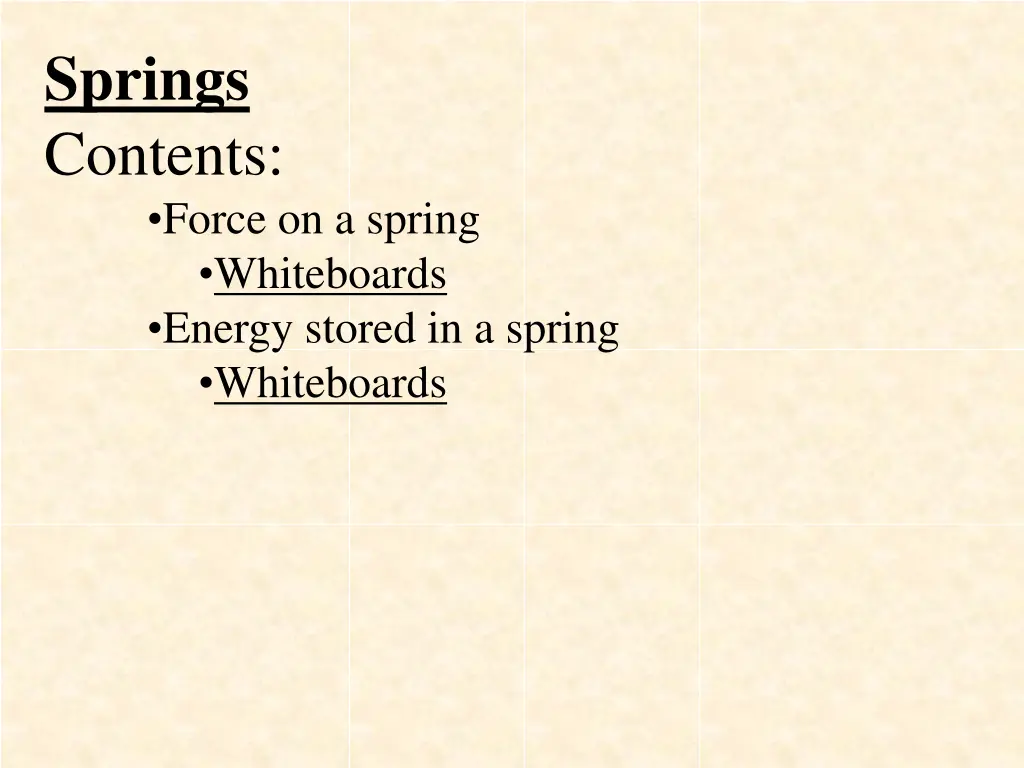
Understanding Springs: Force, Energy, and Stiffness
Explore the principles of springs including force on springs, energy stored, and spring constants. Learn how to calculate forces, distances, and energy stored in springs through practical examples. Discover the relationship between force, stretch distance, and stiffness to enhance your understanding of spring mechanics.
Download Presentation

Please find below an Image/Link to download the presentation.
The content on the website is provided AS IS for your information and personal use only. It may not be sold, licensed, or shared on other websites without obtaining consent from the author. If you encounter any issues during the download, it is possible that the publisher has removed the file from their server.
You are allowed to download the files provided on this website for personal or commercial use, subject to the condition that they are used lawfully. All files are the property of their respective owners.
The content on the website is provided AS IS for your information and personal use only. It may not be sold, licensed, or shared on other websites without obtaining consent from the author.
E N D
Presentation Transcript
Springs Contents: Force on a spring Whiteboards Energy stored in a spring Whiteboards
Force on springs F = kx F = restoring force (in N) k = spring constant (in N/m) (spring stiffness) x - Amount the spring has been distorted (in m) (stretched,/compressed) (show stretch amount, and force) A spring requires 15 N to stretch 42 cm. k = ? F = kx 15 N = k(.42 m), k = (15 N)/(.42 m) = 35.7 N/m
Whiteboards: Force on springs 1 | 2 | 3
Ali Zabov stretches a 53 N/m spring 13 cm with what force? F = kx = (53 N/m)(.13 m) = 6.89 N = 6.9 N 6.9 N
Nona Zabov allows the weight of a 2.1 kg mass to stretch a 35 N/m spring. What distance does it stretch? F = ma, weight = mg F = kx F = (2.1 kg)(9.8 N/kg) = 20.58 N F = kx, x = F/k x = (20.58 N)/(35 N/m) = .588 m = .59 m .59 m
Fyreza Goodfellow has a mass of 75 kg. When he gets into his car the springs settle about 6.8 cm. What is the aggregate spring constant of his suspension? F = ma, weight = mg F = kx F = (75 kg)(9.8 N/kg) = 735 N k = F/x = (735 N)/(.068 m) = 10808 N/m = 11000 N/m 11000 N/m
Energy Stored in springs Force vs Stretch F = kx Restoring Force in N 40 F = 0 30 Average force: F = 1/2kx 20 10 0 0 0.2 0.4 0.6 0.8 1 1.2 Stretch distance in m Work = Fs, but which F to use? Let s use the average force: F = 1/2kx W = Fs = (1/2kx)(x) = 1/2kx2 Eelas = 1/2kx2
Whiteboards: Elastic Potential Energy 1 | 2 | 3
Mary H. Little-Lamb stretches a 24 N/m spring 15 cm. What energy does she store in it? Eelas = 1/2kx2 = 1/2(24 N/m)(.15 m)2 = .27 J .27 J
A spring stores 56 J of energy being distorted 1.45 m. What is its spring constant? Eelas = 1/2kx2 k = 2Eelas/x2 = 2(56 J)/(1.45 m)2 k = 53.3 N/m = 53 N/m 53 N/m
What amount must you distort a 14.5 N/m spring to store 98 J of energy? Eelas = 1/2kx2 x = (2 Eelas/m) = (2(98 J)/(14.5 m)) = 3.7 m 3.7 m
How much work is it to stretch a 23.5 N/m spring from 1.14 m to 1.56 m of distortion? (2) Eelas = 1/2kx2 (What is the difference in the stored energy of the spring?) initial energy = 1/2kx2 = 1/2(23.5 N/m)(1.14 m)2 = 15.2703 J final energy = 1/2kx2 = 1/2(23.5 N/m)(1.56 m)2 = 28.5948 J change in energy = work = 28.5948 J - 15.2703 J = 13.3245 J Or, average force = kx = (23.5 N/m)(1.35 m) = 31.725 N (1.35 is average distance) Work = Fs = (31.725 N)(1.56-1.14) = 13.3245 J 13.3 J
